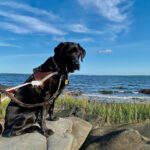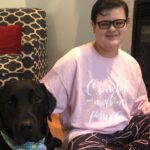Assessing and avoiding canine injuries.
by Jon Osborn
Few situations are more frustrating, emotionally taxing, and downright expensive than injuries to our dogs. Depending upon the severity, these maladies can range from costly inconveniences to scenarios where the dog has to sit out from exercise and playtime and the family finances take a royal beating.
Then there’s that murky matter of assessing injuries. Is Fido favoring a leg, or is that limp something that will pass? Were we able to remove all those porcupine quills? What’s that gurgling sound coming from his stomach? Should I make an emergency trip to the vet, or simply keep a close eye on things?
We’ve all asked these questions – and if you’re anything like me, you’ve probably over- or underreacted a time or two, as well. Philosophies vary widely, with extremes on both ends of the spectrum. I’ve got buddies who will race to a 24-hour clinic to get a hangnail treated, and others who wait months to get a chronic limp checked.
Here’s the hard truth: No matter how much time and effort we invest into care for our canine companions, our “expertise” seldom rises to the level of a professional veterinarian.
Dr. RuthAnn Lobos is a senior veterinarian for Nestle Purina PetCare. Her list of credentials includes managing the Global Scientific Programs and Events for the Purina Institute, which advances the science of nutrition and helps pets live better, longer lives. Dr. Lobos hails from Boulder, Colorado, where she lives with her husband, son, and two dogs. She’s also an adult-onset hunter and a hard-core distance runner, so she understands the importance of nutrition for athletes – both human and canine.
I asked Dr. Lobos if she could share her formula for evaluating situations that have moved beyond the average dog owner’s abilities. “Behavior speaks volumes,” she said.
“Look for abnormalities in personality and routine, along with obvious trauma. For instance, most sporting dogs [Labs are in the AKC Sporting Group] have a healthy appetite, so not eating might be a warning sign. In addition, look for visual cues, like panting, pulling away, and lethargy. Behaviors are specific to individuals – and handlers typically know what’s normal better than anyone.
“Acute or sudden onset changes are also indicative of issues,” Dr. Lobos added. “Anything projectile in nature, vomiting or diarrhea, are tell-tale signs. Explosive vomiting often indicates some kind of intestinal blockage, and chronic diarrhea can rapidly lead to dehydration from fluid loss. If any symptom lingers more than three to four days, it’s time to seek professional assistance.”
Proper conditioning plays a big role in injury prevention. Walking a dog on a leash is great for fresh air and socialization, but it’s a relatively low-level exercise and isn’t sufficient for keeping an active dog in optimal condition.
“Working dogs need to stretch their legs regularly to keep their muscular and cardiovascular systems in tip-top shape. You aren’t setting yourself or your dog up for success by simply walking a few miles on a leash,” Dr. Lobos said, explaining that active dogs employ a lot of “explosive movement and quick directional changes,” whether it’s a Lab chasing a bird, hiking over uneven terrain, or romping in the yard after a tennis ball. “Even a brisk walk won’t prepare a dog for this kind of activity, and lack of conditioning can lead to a host of preventable medical issues.”
Dr. Lobos encourages exercises like swimming, roading, hill workouts, and off-leash running. And here’s one I hadn’t heard of: doggy squats. Simply alternate between sitting and standing. It’s a great exercise for conditioning and responding to voice commands.
Regarding weight control, Dr. Lobos referenced the Purina Lifespan Study, a canine analysis conducted between 1987 and 2001. This revealing, 14-year experiment confirmed that maintaining a healthy weight increased canine longevity by 15 percent, or roughly two years in the 48 Labrador retrievers that were observed. In other words, lean dogs lived longer and experienced fewer medical issues (like cruciate ligament tears) than overweight dogs.
Small surprise there, but there’s more: “Protein plays a huge role in muscle recovery,” Dr. Lobos added. “Humans tap into carbohydrates – glycogen – and aren’t very good at using fat for energy. Dogs are preferential fat burners and require fat for endurance. Adequate amounts translate into longer, higher-quality hunts.”
As far as other preventable injuries, Dr. Lobos mentioned one of her pet peeves: removing a dog from a kennel and immediately getting into action. Ditto for allowing the dog to leap from the tailgate after riding in a crate. “In both cases, all that blood is pooled in the muscles, and it can’t adequately circulate due to the cramped conditions, which often leads to injuries.” It’s an easy fix: assist dogs onto the ground rather than allowing them to jump down, and make time for a warmup prior to starting the activity.
Dr. Jennell Appel (or “Doctor J,” as she’s known) is a prominent veterinarian in the field, and she agrees with Dr. Lobos’s assessment. “It drives me crazy,” she says. “It [jumping to the ground from an elevated position] causes undue stress on the joints, especially in the forelimbs.”
Doctor J has been in the business of canine rehabilitation for more than 20 years. She specializes in postoperative rehabilitation, sports medicine, athletic conditioning, and injury prevention, and she’s a strong proponent of allowing dogs to warm up before starting any activity. A warmup? For dogs? If a canine rendition of Richard Simmons in a jogging suit comes to mind, that’s not what she’s referring to. She’s simply talking about starting a day with a slow walk, which promotes blood flow to soft tissue, and is essential for injury prevention.
“Cooling down is just as critical,” Doctor J added. And it’s not any more complex than taking a slow leash walk at the end of the day to allow the heart rate to decrease gradually and draw blood from the extremities. This keeps the blood from pooling in the muscle bellies, where lactic acid builds up and causes stiffness, restricting range of motion through the joints.
Ironically, many handlers expect portly dogs to perform like athletes, but Doctor J echoed Dr. Lobos’s assessment about overweight, under-conditioned dogs. Year-round fitness is preferable, but sometimes busy schedules hijack the best intentions. Doctor J recommends beginning a conditioning program at least eight weeks before the start of an activity’s season.
“Roading [exercising dogs alongside an ATV, UTV, bicycle, or truck] is a great way to improve fitness,” she said. “Begin with a ten-minute trot [five- to six-mph pace] twice weekly. Add five minutes every week, eventually working up to thirty- to thirty-five minute sessions. Water workouts offer a low-impact exercise option during the hot summer months. Start with five-minute swims, twice weekly, adding two minutes to each session, until fifteen-minute sessions are possible.”
Fitness is part conditioning and part nutrition, and the latter is equally important for overall health. Furthermore, working canines run a higher risk of soft-tissue injury when muscles become fatigued and depleted during activity, and Doctor J said a proper ratio of protein and fat is essential for optimal performance in the field. “A balanced diet helps maintain energy levels and improves muscular endurance and VO2 max [oxygen metabolism]. In short, the less fatigued soft tissue becomes, the less stress is placed on tendons, ligaments, and joints.”
That’s where quality kibble from a reputable manufacturer like Purina comes in. Purina Pro Plan Performance contains high levels of omega-3s for joint support, along with glucosamine and live probiotics for gut health.
Canine injuries aren’t always immediately apparent, which is why performing a “tailgate assessment” when you’re done is so important. Unfortunately, it isn’t always easy to convince hard-driving dogs to sit still immediately after shutting down for the day, making it difficult to perform a thorough examination. In addition, excited and active dogs receive a healthy dose of adrenaline, which tends to diminish pain response.
Although a cursory post-activity check is important, one of the best times to evaluate lameness or stiffness/soreness is two hours after activity, according to Doctor J. By then, the dog’s respiratory and circulatory systems have returned to resting levels, which draws blood away from extremities, so stiffness is more noticeable. The morning after is another prime time to evaluate gait and check for lameness.
“If an injury is suspected, place a soft ice pack or bag of ice on the affected area. Compressing it with Vet Wrap or an Ace bandage helps the cold penetrate deeper into tissue. Apply for fifteen minutes, then remove. This can be repeated two to three times a day,” Doctor J suggested.
“Incorporate an anti-inflammatory medication to diminish pain and inflammation, but only use medicine that has been prescribed and dosed by a veterinarian. Administer with a full meal to protect the G.I. tract, and do not continue the treatment beyond seventy-two hours without an exam or consultation.”
None of these recommendations are rocket science, but it’s easy to overlook this advice. Here are a few summary tips to remember:
- Watch for abnormalities in behavior. If something seems amiss, take it seriously.
- Take a few seconds to lift your canine companion out of the kennel and warm up before beginning any activity. The same philosophy of care applies afterward. Allow the dog to cool down and then perform a cursory tailgate check for potential injuries.
- Quality food contributes to overall health and injury prevention.
- Keep your Lab lean. Some owners express affection through copious table scraps and treats, but real love sets limits, and the dog benefits in the long run.
- Exercise is important throughout the year – not just leash walks around the neighborhood, but especially off-lead exercise, roading, and water workouts.
An ounce of prevention really is worth a pound of cure. When in doubt, enlist the guidance of a trusted veterinarian.
Dr. Lobos’s List of Essential Items Every Lab Owner Should Carry Afield:
Nylon slip lead: Lightweight and multi-purpose, nylon leashes are great for crossing busy roads, or restraining Fido from chasing skunks, porkies, or deer. They do double duty as makeshift muzzles if your dog gets cut or quilled. Plus, they’re excellent makeshift tourniquets.
Multi-tool: Use pliers for pulling quills or thorns.
Small bottle of sterile saline: Debris can build up in a dog’s eyes, and saline is a great in-field flush. Plus, saline is the “solution for pollution” when irrigating abrasions and lacerations.
Adequate drinking water: Remember to bring more water than you think you need. Dogs can get dehydrated even in cold conditions.
Three Red Flags According to Doctor
Since Labs, no matter how expressive, can’t articulate how they feel with words, certain red flags may indicate an injury. A post-activity analysis includes the following:
- Manipulate limbs to check for hot spots or swelling. Start at the paw and progress upward with each leg. Visually compare the right from left to determine if something feels or appears abnormal.
- A creative option for evaluating gait involves using a cell phone to take slow-motion video while the dog is walking and trotting forward and away. If there is a distinct “head bob” (movement of the head up and down indicating a forelimb lameness), the leg on the ground when the dog lifts his head up away from the ground is typically the culprit.
- A three-leg stand is an easy strength test. Pick up one hind leg and hold it up. The dog should be able to bear weight on the opposite hind limb for 10 seconds without trying to sit down or pull the leg away. The same is true for the front limbs. If the dog is unable or unwilling to bear weight on the leg that is still on ground, there may be discomfort or injury in that limb.




